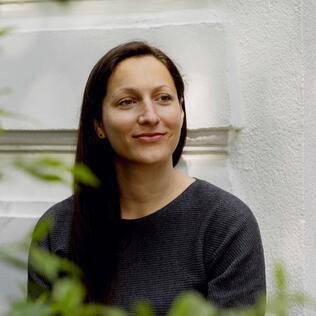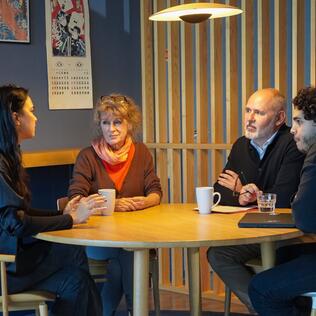Diversity and equal opportunitiy at Otto Group

Diana Sommerfeld is the Diversity Manager at the Otto Group. Together with three colleagues, she is working on the question of which strategies can help us to earnestly live out diversity and equal opportunity in companies and subsidiaries. And how all employees can develop their full potential.
Diversity has been in focus in the Otto Group longer than in other corporations. How did the interest in diversity start here?
More than ten years ago now, it was becoming increasingly clear to us that we needed to be more diverse when seeking talent to stay competitive. Another aspect of this was that
Which project as the first major one?
This was the “Power of Diversity” initiative, which has been around since 2012–2013 and specifically deals with the promoting the careers of women in management positions. As always, it enjoys the support of our Executive Board Member Petra Scharner-Wolff. It has been and still is very important that people from the uppermost executive levels – like Petra and Sergio Bucher on the Executive Board – support such programs and promote them. After all, they exude a certain radiance in the Group and can channel the necessary resources and decisions that are needed for setting up diversity projects.
How did things continue after “Power of Diversity” started?
The topic of diversity kept getting bigger and bigger. In 2015, OTTO was the first Group company to establish its own diversity management. A key moment of this was most definitely when Plan F, the first OTTO women’s network, was founded in 2016. Since then, it has been working on topics such as financial independence, women in management positions, and women in tech. The last topic then developed into Develop<Her>, an in-house digital camp established by PLAN F, which is primarily aimed at women and girls to pique their interest in tech topics. Something else formed at OTTO was #experience, a consortium that focuses on the interests of over-50-year-old employees. In addition to this, numerous grassroots movements were also being launched in other Group companies by the workforce, which is calling for increased diversity. Bonprix and EOS, which are also quite committed to actively working with the topic, are examples of this. In the meantime, many other Group-wide networks have started up as well, such as the LGBTIQ* network MORE* and the antiracism community antiRacism.
The first thing that needs to be done is to create awareness of the topic in question within the company.
What specifically do these communities do?
The first thing that needs to be done is to create awareness of the topic in question within the company. For example, what the interaction with sexual orientation means in the work context. And why lesbian, gay, and transexual persons are unable to freely and easily talk about their last vacations when there is not an open culture in the company. The networks then set topical emphases, which are often followed for a year. To do this, PLAN F is developing various workstreams, such as on the topic of women and financial provision. In addition, the communities cooperate with institutions outside the Group. For instance, MORE* has sponsored the “Fluchtursache Liebe” (“Reason for Exodus: Love”) exhibit in the Hamburg Emigration Museum of BallinStadt. And the networks naturally help with all kinds of issues and concerns.

Since 2020, there has been a Group-wide diversity community as well. Why did this need to be established?
It was necessary to have a place where all the different communities can come together, an entity with an overview of what the individual networks had already done and what was now being worked on. This enables us to promote the exchange between the various grassroots movements, which is important, since a community may have already focused on a topic that is just now becoming important to others. In this way, everyone can profit from each other’s experiences. That is why, in our first project, we worked on solutions for greater transparency in topics of diversity and inclusion (D&I). 2021 was our Year of Transparency. We have created a D&I book in which we tackled the seven diversity dimensions of the Diversity Charter association.
Could you please briefly explain what the Diversity Charter is?
The Diversity Charter, or Charta der Vielfalt, is a non-profit association. Its mission is to make the topic of diversity socially acceptable and to emphasize its importance for companies and their employees. The seven diversity dimensions of the Charter are age, social background, ethic origin and nationality, sexual orientation, sex and gender identity, physical and mental abilities, and religion and worldview. Now when a company signs the Diversity Charter – and we did this as a holding company, like many of our Group companies as well – then it is a statement. Then the company is also responsible to implement the objectives of the Charter, thereby taking diversity seriously, promoting it, and recognizing it.
We need patience, high-tolerance for frustration, and continuity – change does not happen overnight.
And how do you do that?
During the Year of Transparency we were just talking about, we took on another dimension of the Charter every other month. We took a good look at ourselves to see in which areas things are already going well in the Otto Group and where we still need to catch up. That is why we have been communicating with our communities and setting up meetings where experts outside the company have participated as well. By doing this, we have analyzed which processes still have to be prodded to allow more diversity to thrive and where we have already achieved a good deal. Yet it is clear: We need patience, high-tolerance for frustration, and continuity – change does not happen overnight. When I look at the quota of women in management positions at the German companies of the Otto Group, I see right away that we still have a ways to go. Then I observe the high number of women in part-time positions and note again that women in management rarely work part-time. For us, this indicates that management does not perceive part-time work as being a comprehensive normality. And so we are considering how to change this. In order to deal with such core issues better and analyze our challenges more quickly, we have developed a diversity strategy.
What does this look like?
It has three pillars: “Envision, Embrace, Grow,” or EEG for short. “Envision” encompasses the entire topic of numbers and facts. We define, or rather formulate objectives in measurable quantities, how we envision a future in which we are as colorful and diverse as we want things to be in the Otto Group. In order to show management and the Executive Board where we want to go and to say what we need for this, we need measurable criteria. “Embrace” is also about culture. In other words, how do we approach the workforce on the topic of diversity. How do we enable them to truly live in equal opportunity and diversity – and not only perceive these things as somehow appearing important while not necessarily requiring active participation. And finally, “Grow” shows which measures the Group companies and we need to take in order to actually achieve the objectives formulated within “Envision.”
How important is a strategy like this for the Otto Group’s commitment to Hamburg Pride?
It is an important statement, showing that we are on the side of the LGBTIQ+ community. But it is only one initiative among many and not a key moment along our D&I path. For me, it is significant what is happening on the inside, which things we continually pursue, how we implement them and integrate them into our culture. And ultimately how seriously we take diversity and equal opportunity. And I truly think that we have the right mindset and are already doing a great deal. Naturally, it is right to show this on the outside.

To what extent do you interact with other companies concerning D&I issues?
We discuss them with a great many companies from Hamburg and throughout Germany. We find it very interesting how others are setting up D&I and what their strategy is. We can learn a lot, and it is generally better to approach major topics jointly. The communities from our Group companies have joined forces with other company communities and are networking worldwide. This happens frequently, and such an external extension is essential. For, in this way, we prevent ourselves from merely being stuck in our own bubble. It shows us whether we are really tackling the important topics.





